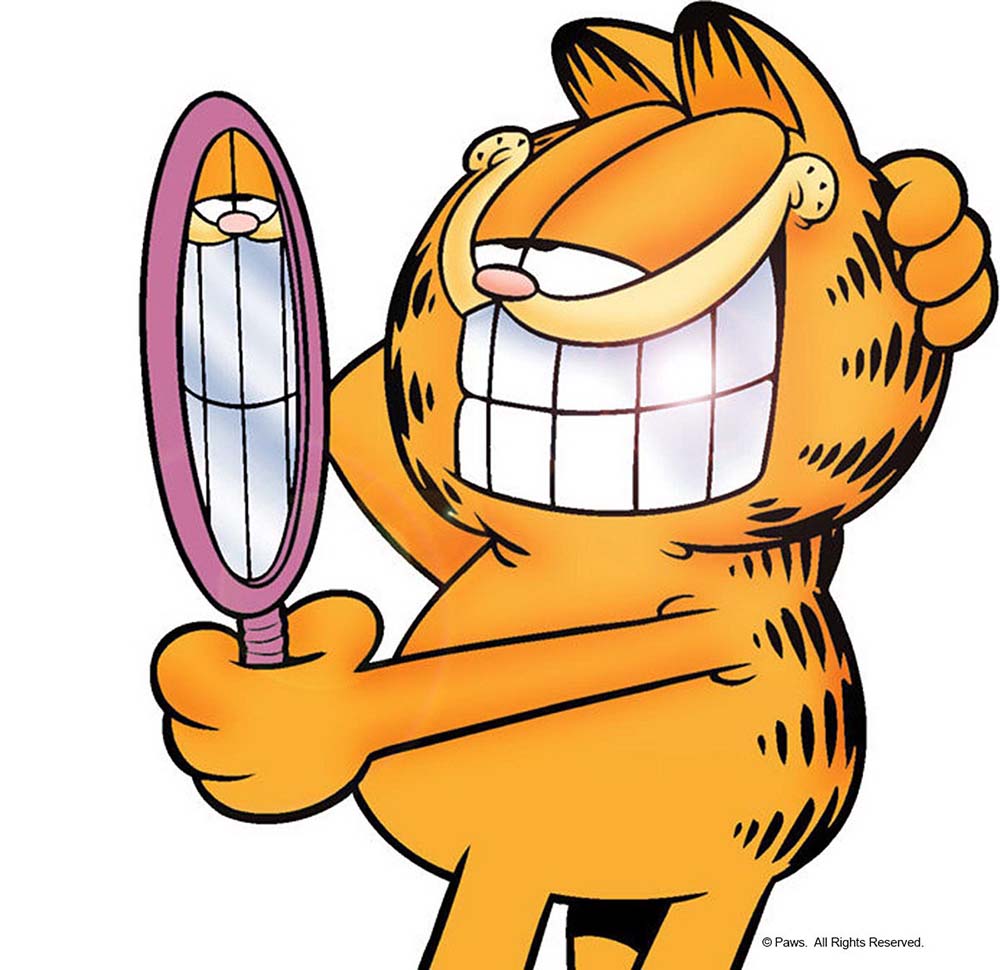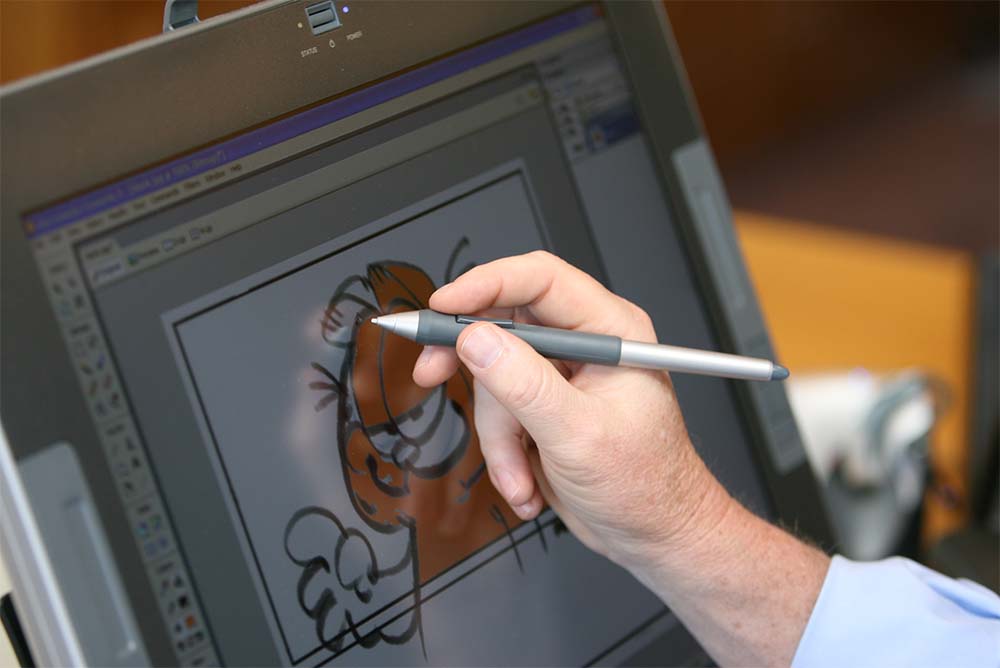Jim Davis
Garfield's cartoonist
US
The fat, sluggish, tabby cat Garfield with his orange, black striped fur is world-famous as it is „the most widely syndicated comic strip in the world“ (in 2.100 papers in 111 countries and in 28 languages!). But the name of his creator is often only familiar to those who also read the signature on the cartoons. There it says: Jim Davis.
Jim Davis
Garfield's cartoonist
US

Cats have played a significant role in his life right from the very beginning. His parents' cattle farm in Fairmount, Indiana, where he grew up, was populated by 25 cats already. Because of his asthma, the junior (* 28 July 1945, Marion/Indiana) often had to stay in the house and thus discovered drawing for himself. After graduating from university and working in an advertising agency, he worked as an assistant to comic artist Tom K. Ryan ('Tumbleweeds'). When Davis had created a new comic character, he named him after his grandfather. The very first strip, centred on a fat, lazy and sarcastic house cat, was published in 1977, then in 41 US newspapers from 19 June 1978. In 1981, PAWS Inc. was founded, controlling the rights to Garfield and the over 3,500 products under his name. In the same year, the "National Cartoonists Society" (NCS) named Jim Davis the best comic humourist of the year - the first of many awards, the most important of which is an honorary doctorate from the university where he once studied. For his animated Garfield works, the American cartoonist received an Emmy four times, the most important television prize in the United States. Between 1988 and 1994, a total of 121 30-minute episodes of the animated series 'Garfield and his Friends' ran on television there. In 2004, 'Garfield - The Movie' was released in cinemas, followed by four more. In 2008, 'The Garfield Show' started on US TV. It is licensed in 131 countries (including daily broadcast in China). Since 1980, the New York Times bestseller list has listed a full 33 of his comic books, which have been translated into 27 languages and found over 130 million buyers. The works of the comic author, who is involved in a variety of social activities and plays golf or fishes in his spare time, are still printed in 2,570 newspapers and reach 263 million readers worldwide. Therefore it was a logical step to feature 'The Art of Jim Davis‘ Garfield' in a book of the same name (256 pages, Hermes Press).
Jim Davis is married for the second time, has three children, a cat named Nermal and the dog Pooky. He lives with them in Muncie, Indiana, on a sprawling estate that also houses his company. “The novelty’s not worn off”, Davis confessed in an interview with the British daily newspaper The Guardian on Garfield’s 40th birthday, „because I’m still trying to get it right!“
Interview May 2016
Hard work: a fat, lazy cat's road to world fame
"Intuitions just come, arise and then are there," Dieter Blum reveals in the exhibition space of a gallery in southern Germany. "For me, this sometimes happens while I'm working. After 15 years of photographing cowboys, the so-called hard men, it almost provoked me to create a counterpart - faces of women at the height of sex." To illustrate, he points to the large-format photo prints from his "Cowboys" and "Coming Soon" series hanging on white walls.
"I usually get the best ideas when I'm asleep and dreaming", the artist, dressed in a dark jacket, scarf, jeans, light shirt and sports shoes, confesses a little later. "Suddenly I'm wide awake and have the idea in my head. I then make notes in shorthand - in the past on pieces of paper, nowadays on my smartphone." An example of this is his nude photo "Michelangelo I". "This is exactly how I had it in my mind's eye and immediately drew it." Before the realisation, Blum showed the sketch to the model, a first-class dancer. He said it was not easy to realise, but tried it anyway. He had to jump stretched out and, because it was impossible to roll on landing, let himself fall with his chest on the screed floor of the studio. The jump took 0.1 seconds. The Hasselblad camera Blum used took 1.8 seconds to wind up. This means that exactly one photo is possible. "The model jumped three times and all three shots are first class. No one in the world has ever taken such a photo! I demanded everything from the dancer and from myself. That's how I got the result the way I wanted it. The magic of the moment is crucial! If it's missing, then something can be technically perfect, but it's also soulless."
The result, by the way, has nothing to do with chance, but "is only feasible due to complete attention and total professionalism". That is why, in addition to intuition, inspiration and creativity, his work also involves craftsmanship. A confirmation of the saying "art comes from skill"? "In photography, you can't learn that at university," Blum emphasises. "Either you are a person who sees really well and can realise it or you are not. You can learn technique and maybe a bit of looking. But nothing more." The Senegalese poet and former head of state Léopold Sédar Senghor attested to the fact that he has a very special eye in the foreword to the illustrated book "Africa". It is a gift that Blum was not born with, "because I have no ancestors with such talent". It was already clear to him at the age of eight that he did not want to take over his parents' textile shop, but to become a photographer.
"I either realise an idea very quickly or it is completely stuck in my mind and will be realised at the next shoot", the professional reports. Photography inspires him to this day because he considers it his hobby. "On the one hand, the creative process is something loose for me. I work as if in a trance, but the encounter between photographer and model takes place at eye level. Sometimes I motivate accordingly or even sketch out how I would like something to look. However, I also leave room for manoeuvre because actors sometimes have super ideas." From this something common emerges. "On the other hand, I have to admit to being a driven person, because I never give in to myself. When I do a project, it has to be down to the last detail for an optimal result. Giving up before that doesn't exist for me!"
Once the shoot is in the can, Dieter Blum immediately looks at the results, makes a first selection. In the case of free works for himself personally, he only takes another look two weeks later and sorts out more than half. "Because I am so merciless towards myself, I throw away everything that doesn't completely satisfy me." This radically reduces the rest. In the end, the shots that remain are those whose expression and message work the way the photographer wants them to. "I can see immediately if there is something really outstanding. I don't let myself be distracted by anything." He is far too critical of his own work to have ever turned in anything mediocre. "And even criticism from others I have always been able to accept." His wife, by the way, is his harshest critic. "Sometimes, though, I stand over it and say I think something is better because I know the photo works from my perspective."
Such a strict standpoint, as Blum has held from the very beginning, does not usually make it easy for a self-employed person. This is exemplified by the assignment that was to establish his worldwide fame and turn his photos into icons. Yet everything could have turned out quite differently, because "I was already very busy at the time in question and I didn't care at all whether I got the job or not." In 1992 he was invited to a test shoot for the global "Marlboro" campaign. Klaus-Erich Küster, creative director of the worldwide advertising agency group "Leo Burnett", told him that he should exclusively realise his own ideas. Blum took this literally: the head of the marketing department was enthusiastic about the photo, bathed in lantern light, of a cowboy sitting on a white horse next to parked cars and designed nine advertisements. "Not one of them was taken, because the clients were completely horrified by my pictures! They said it was a disaster because there was nothing left of the Marlboro idea! I retorted, "I don't see it that way!" Blum's unwavering persistence was to pay off. "Six months later I got the call that they would like my shots after all and I was the only European to get the assignment to photograph their worldwide advertising campaign!" For the mega production in the US state of Utah, the shooting star suddenly even had a helicopter, more than a dozen cowboys, 25 horses, 40 head of cattle, wind machines and lights at his disposal, all transported in 20 trucks.
Why one person makes it and the other doesn't, even though they both have the same skills - Blum doesn't know the answer to that. "One person happens to be lucky enough to slip into something and find someone who supports and promotes him, while others whirl around and can't get their foot on the ground." Even for him, the breakthrough took longer than planned. The reason, he believes, was that people could not pigeonhole him. "When one specialises in one subject, it often works better than when one is active in many fields, as I was. I was guaranteed to be ahead of my time many times! In 1976, I made the big illustrated book "The Africa Book", which set standards and sold 23,000 copies within a year at a price of 200 US dollars. That put me in the "Africa" drawer. But then he turned his attention to Japan ("Nippon"), Russia ("USSR: Voyage of Discovery in a Rich Country"), "Cowboys", The Berlin Philharmonic ("The Orchestra"), dance ("Vladimir Malakhov"). "People couldn't keep up, didn't know which pigeonhole to put me in. That's a problem - but not for me."
Photography has been recognised as art at least since dOCUMENTA 6 in 1977. However, the criteria used to categorise what is art and what is not remain a mystery not only to Dieter Blum. "The American painter and photographer Richard Prince photographed sections of motifs from the Marlboro advertising campaign - including some of mine - and sold these edited reproductions as art. Among them was a very famous picture for which 1.3 million US dollars were paid. However, the original "Rider against a Blue Sky", which came from me, was only second choice for me. That Prince variant is valuable art is probably because the former is pushed by influential galleries." A curious experience in this context was at the Swiss art fair Art Basel 2011, where Blum showed a gallery owner his work - including the aforementioned photo. He was then told that this was too close to Richard Prince. The German photographer replied, "But my work is the original." His counterpart only said, "Nevertheless!".
MY FAVORITE WORK

